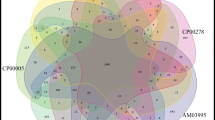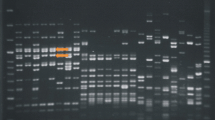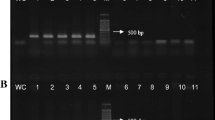Abstract
DNA of Leifsonia xyli subsp. xyli (Lxx), the causal agent of ratoon stunting disease of sugarcane, was detected in the fibrovascular fluid of sugarcane plants using random amplified polymorphic DNA PCR-based amplification using two 10-mer oligonucleotide primers. The primers OPC-02 and OPC-11 produced Lxx-specific markers of approximately 800 bp and 1000 bp, respectively. A cloned DNA fragment from the 800 bp PCR product (pSKC2-800) hybridised to a single genomic DNA fragment from Lxx when used as a probe in Southern hybridisation. This cloned fragment did not hybridise to L. xyli subsp. cynodontis (Lxc), or L. xyli-like bacteria isolated from grasses in Australia, indicating the usefulness of this DNA fragment as a specif ic probe for Lxx. A cloned fragment from the 1000 bp PCR product (pSKC11-1000) hybridised to three genomic fragments in Lxx isolates, one genomic fragment in two of the four isolates of L. xyli-like bacteria, and in two of the four isolates of Lxc isolated from the USA. These results indicate that L. xyli-like bacteria are more likely to be related to Lxc than Lxx. These probes did not hybrid ise to the DNA from strains of the species of Clavibacter, Rathayibacter, Acidovorax, Ralstonia, Pseudomonas and Xanthomonas tested. Two oligonucleotide primers (21-mer) designed from the pSKC2-800 sequences specifically amplified template DNA from Lxx and detected as few as 5 × 104 cells/mL in fibrovascular fluid from sugarcane plants infected with Lxx.
Similar content being viewed by others
References
Boucher CA, Barberis PA, Trigalet PA, Demery DA (1985) Transposon mutagenesis of Pseudomonas solanacearum: isolation of Tn5-induced avirulent mutants. Journal of General Microbiology 131, 2449–2457.
Chung CH, Lin CP, Chen CT (1994) Development and application of cloned DNA probes for Clavibacter xyli subsp. xyli, the causal agent of sugarcane ratoon stunting. Journal of Phytopathology 141, 293–301.
Croft BJ, Smith GR (1995) Major diseases affecting sugarcane production in Australia and recent experiences with sugarcane diseases in quarantine. In ‘Sugarcane germplasm conservation and exchange’. ACIAR Proceedings No. 67, Brisbane. (Eds BJ Croft, CM Piggin, ES Wallis, OM Hogarth), pp. 55–58. (Australian Centre for International Agricultural Research: Canberra)
Damann KE, Derrick KS, Gillaspie AG, Fontenot DB, Kao J (1978) Detection of the RSD-associated bacterium by serologically specif ic electron microscopy. Proceedings of the International Society of Sugar Cane Technologists 16, 433–437.
Davis MJ, Dean JL (1984) Comparison of diagnostic techniques for determining incidence of ratoon stunting disease of sugarcane in Florida. Plant Disease 68, 896–899.
Davis MJ, Gillaspie Jr, AG, Harris RW, Lawson RH (1980) Ratoon stunting disease of sugarcane: Isolation of the causal organism. Science 210, 1365–1367.
Elder RT, Loh EY, Davis RW (1983) RNA from the yeast transposable element Ty l has both ends in the direct repeats, a structure similar to retrovirus RNA. Proceedings of the National Academy of Sciences (USA) 80, 2432–2436.
Fegan M, Croft BJ, Teakle DS, Hayward AC, Smith GR (1998) Sensitive and specific detection of Clavibacrer xyli subsp. xyli, causal agent of ratoon stunting disease of sugarcane, with a polymerase chain reaction-based assay. Plant Pathology 47, 495–504.
Gillaspie AG (1978) Ratoon stunting disease: serology, Phytopathology 68, 529–532.
Gillaspie AG, Harris RW (1979) Limitations of ELISA for detection of the RSD-associated bacterium in sugarcane and sudangrass. Sugarcane Pathologists Newsletter 15/16, 34–36.
Gillaspie AG, Teakle DS (1989) Ratoon stunting disease. In ‘Diseases of sugarcane: major diseases’, (Eds C Ricaud, BT Egan, AG Gillaspie, CG Hughes) pp. 59–80. (Elsevier: Amsterdam)
Harris RW, Gillaspie AG (1978) Immunofluorescent diagnosis of ratoon stunting disease. Plant Disease Reporter 62, 193–196.
Hayward AC (1960) A method for characterizing Pseudomonas solanacearum. Nature 186, 405–406.
He Q, Marjamaki M, Soini H, Mertsola J, Viljanen MK (1994) Primers are decisive for sensitivity of PCR. BioTechniques 17, 86–87.
Hoisington D, Khairallah M, Gonzalez de Leon D (1994) ‘Laboratory protocols: CIMMYT Applied Molecular Genetics Laboratory (2nd edn).’ (Mexico DF: CIMMYT)
Hughes CG, Steindl DRL (1955) Ratoon stunting disease of sugarcane. Queensland Bureau of Sugar Experiment Stations Technical Communication No. 2.
Hughes CG, Steindl DRL (1956) Some further developments in the study of ratoon stunting disease in Queensland, Proceedings of the International Society of Sugar Cane Technologists 9, 1012–1022.
Marchuk D, Drumm M, Saulino A, Collins FS (1990) Construction of T-vectors, a rapid and general system for direct cloning of unmodified PCR products. Nucleic Acids Research 19, 1154.
Mills L, Leaman TM, Taghavi SM, Shackel L, Dominiak BC, Taylor PWJ, Fegan M, Teakle DS (2001) Leifsonia xyli-like bacteria are endophytes of grasses in eastern Australia. Australasian Plant Pathology 30, 145–151.
Pan Y-B, Grisham MP, Burner DM, Damann KE, Wei Q (1998) A polymerase chain reaction protocol for the detection of Clavibacter xyli subsp. xyli, the causal bacterium of sugarcane ratoon stunting disease. Plant Disease 82, 285–290.
Richardson SR (1978) An improved method of xylem-sap extraction using positive pressure for the rapid diagnosis of ratoon stunting disease. Sugarcane Pathologists Newsletter 21, 17–18.
Riley IT, Ophel KM (1992) Clavibacter toxicus sp. nov., the bacterium responsible for annual ryegrass toxicity in Australia. International Journal of Systematic Bacteriology 42, 64–68.
Rogers SO, Bendich AJ (1985) Extraction of DNA from milligram amounts of fresh, herbarium and mummified plant tissues. Plant Molecular Biology 5, 69–76.
Sambrook J, Fritsch EF, Maniatis T (1989) ‘Molecular cloning: a laboratory manual (2nd edn).’ (Cold Spring Harbour: NY)
Steindl DRL (1950) Ratoon stunting disease. Proceedings of the International Society of Sugar Cane Technologists 7, 57–65.
Taylor PWJ, Ryan CC, Birch RG (1988) Harvester transmission of leaf scald and ratoon stunting disease, Demonstration and evaluation of methods of decontamination. Sugar Cane July/Aug, 11–14.
Teakle DS, Ryan CC (1992) The effect of high temperature on the sugar cane ratoon stunting bacterium, Clavibacter xyli subsp. xyli, in vitro and in vivo. Sugar Cane 6, 5–6.
Author information
Authors and Affiliations
Corresponding author
Rights and permissions
About this article
Cite this article
Taylor, P.W.J., Petrasovits, L.A., Vall der Velde, R. et al. Development of PCR-based markers for detection of Leifsonia xyli subsp. xyli in fibrovascular fluid of infected sugarcane plants. Australasian Plant Pathology 32, 367–375 (2003). https://doi.org/10.1071/AP03036
Received:
Accepted:
Issue Date:
DOI: https://doi.org/10.1071/AP03036




